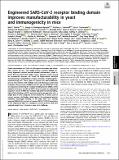| dc.contributor.author | Dalvie, Neil C. | |
| dc.contributor.author | Rodriguez-Aponte, Sergio A. | |
| dc.contributor.author | Hartwell, Brittany L. | |
| dc.contributor.author | Tostanoski, Lisa H. | |
| dc.contributor.author | Biedermann, Andrew M. | |
| dc.contributor.author | Crowell, Laura E | |
| dc.contributor.author | Kaur, Kawaljit | |
| dc.contributor.author | Kumru, Ozan S. | |
| dc.contributor.author | Carter, Lauren | |
| dc.contributor.author | Yu, Jingyou | |
| dc.contributor.author | Chang, Aiquan | |
| dc.contributor.author | McMahan, Katherine | |
| dc.contributor.author | Courant, Thomas | |
| dc.contributor.author | Lebas, Celia | |
| dc.contributor.author | Lemnios, Ashley A. | |
| dc.contributor.author | Rodrigues, Kristen A. | |
| dc.contributor.author | Silva, Murillo | |
| dc.contributor.author | Johnston, Ryan S. | |
| dc.contributor.author | Naranjo, Christopher | |
| dc.contributor.author | Tracey, Mary Kate | |
| dc.contributor.author | Brady, Joseph R. | |
| dc.contributor.author | Whittaker, Charles A. | |
| dc.contributor.author | Yun, Dongsoo | |
| dc.contributor.author | Brunette, Natalie | |
| dc.contributor.author | Wang, Jing Yang | |
| dc.contributor.author | Walkey, Carl | |
| dc.contributor.author | Fiala, Brooke | |
| dc.contributor.author | Kar, Swagata | |
| dc.contributor.author | Porto, Maciel | |
| dc.contributor.author | Lok, Megan | |
| dc.contributor.author | Andersen, Hanne | |
| dc.contributor.author | Lewis, Mark G. | |
| dc.contributor.author | Love, Kerry R. | |
| dc.contributor.author | Camp, Danielle L. | |
| dc.contributor.author | Silverman, Judith Maxwell | |
| dc.contributor.author | Kleanthous, Harry | |
| dc.contributor.author | Joshi, Sangeeta B. | |
| dc.contributor.author | Volkin, David B. | |
| dc.contributor.author | Dubois, Patrice M. | |
| dc.contributor.author | Collin, Nicolas | |
| dc.contributor.author | King, Neil P. | |
| dc.contributor.author | Barouch, Dan H. | |
| dc.contributor.author | Irvine, Darrell J | |
| dc.contributor.author | Love, Christopher J. | |
| dc.date.accessioned | 2021-10-04T16:04:00Z | |
| dc.date.available | 2021-10-04T16:04:00Z | |
| dc.date.issued | 2021-09 | |
| dc.date.submitted | 2021-04 | |
| dc.identifier.issn | 0027-8424 | |
| dc.identifier.issn | 1091-6490 | |
| dc.identifier.uri | https://hdl.handle.net/1721.1/132697 | |
| dc.description.abstract | Global containment of COVID-19 still requires accessible and affordable vaccines for low- and middle-income countries (LMICs). Recently approved vaccines provide needed interventions, albeit at prices that may limit their global access. Subunit vaccines based on recombinant proteins are suited for large-volume microbial manufacturing to yield billions of doses annually, minimizing their manufacturing cost. These types of vaccines are well-established, proven interventions with multiple safe and efficacious commercial examples. Many vaccine candidates of this type for SARS-CoV-2 rely on sequences containing the receptor-binding domain (RBD), which mediates viral entry to cells via ACE2. Here we report an engineered sequence variant of RBD that exhibits high-yield manufacturability, high-affinity binding to ACE2, and enhanced immunogenicity after a single dose in mice compared to the Wuhan-Hu-1 variant used in current vaccines. Antibodies raised against the engineered protein exhibited heterotypic binding to the RBD from two recently reported SARS-CoV-2 variants of concern (501Y.V1/V2). Presentation of the engineered RBD on a designed virus-like particle (VLP) also reduced weight loss in hamsters upon viral challenge. | en_US |
| dc.language.iso | en | |
| dc.publisher | National Academy of Sciences | en_US |
| dc.relation.isversionof | http://dx.doi.org/10.1073/pnas.2106845118 | en_US |
| dc.rights | Article is made available in accordance with the publisher's policy and may be subject to US copyright law. Please refer to the publisher's site for terms of use. | en_US |
| dc.source | PNAS | en_US |
| dc.title | Engineered SARS-CoV-2 receptor binding domain improves manufacturability in yeast and immunogenicity in mice | en_US |
| dc.type | Article | en_US |
| dc.identifier.citation | Dalvie, Neil C. et al. "Engineered SARS-CoV-2 receptor binding domain improves manufacturability in yeast and immunogenicity in mice." Proceedings of the National Academy of Sciences 118, 38 (September 2021): e2106845118. | en_US |
| dc.contributor.department | Massachusetts Institute of Technology. Department of Chemical Engineering | en_US |
| dc.contributor.department | Koch Institute for Integrative Cancer Research at MIT | en_US |
| dc.contributor.department | Massachusetts Institute of Technology. Department of Biological Engineering | en_US |
| dc.contributor.department | Harvard University--MIT Division of Health Sciences and Technology | en_US |
| dc.contributor.department | Massachusetts Institute of Technology. Institute for Medical Engineering & Science | en_US |
| dc.relation.journal | Proceedings of the National Academy of Sciences | en_US |
| dc.eprint.version | Final published version | en_US |
| dc.type.uri | http://purl.org/eprint/type/JournalArticle | en_US |
| eprint.status | http://purl.org/eprint/status/PeerReviewed | en_US |
| dc.date.updated | 2021-10-01T18:21:16Z | |
| dspace.orderedauthors | Dalvie, NC; Rodriguez-Aponte, SA; Hartwell, BL; Tostanoski, LH; Biedermann, AM; Crowell, LE; Kaur, K; Kumru, OS; Carter, L; Yu, J; Chang, A; McMahan, K; Courant, T; Lebas, C; Lemnios, AA; Rodrigues, KA; Silva, M; Johnston, RS; Naranjo, CA; Tracey, MK; Brady, JR; Whittaker, CA; Yun, D; Brunette, N; Wang, JY; Walkey, C; Fiala, B; Kar, S; Porto, M; Lok, M; Andersen, H; Lewis, MG; Love, KR; Camp, DL; Silverman, JM; Kleanthous, H; Joshi, SB; Volkin, DB; Dubois, PM; Collin, N; King, NP; Barouch, DH; Irvine, DJ; Love, JC | en_US |
| dspace.date.submission | 2021-10-01T18:21:17Z | |
| mit.journal.volume | 118 | en_US |
| mit.journal.issue | 38 | en_US |
| mit.license | PUBLISHER_POLICY | |
| mit.metadata.status | Complete | en_US |
